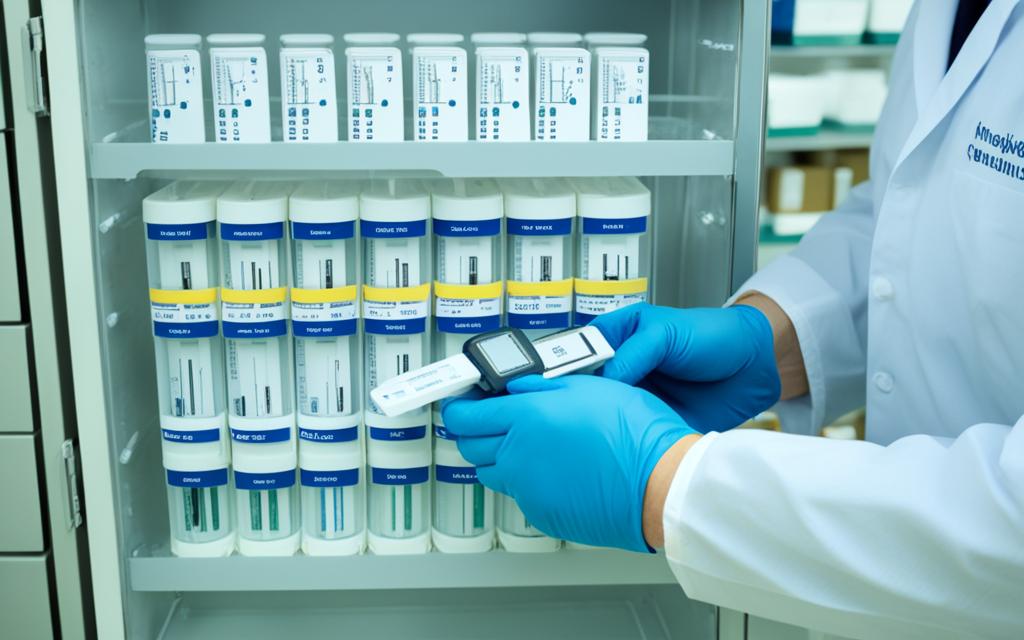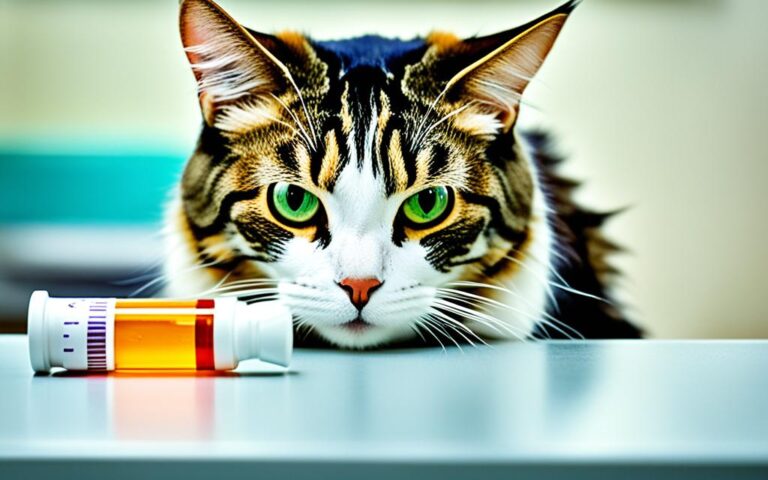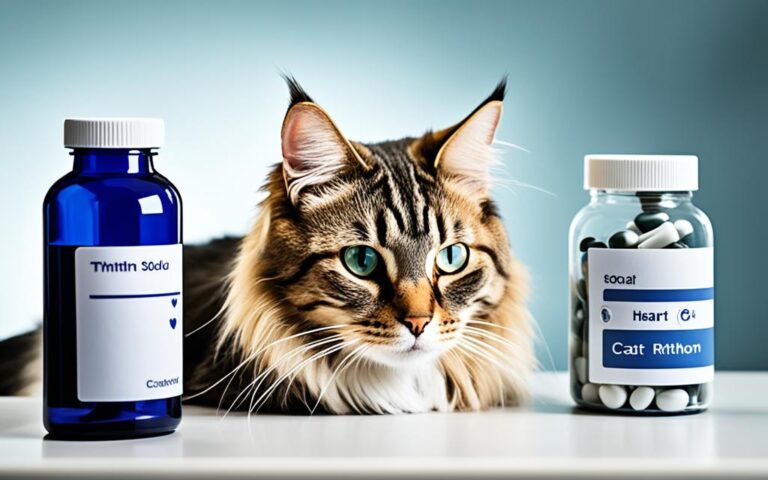Ampicillin for cats: Uses, Dosage & Effects
Ampicillin is a popular antibiotic for cats, treating bacterial infections for years1. It works well, helping over 70% of cats with these infections2. This drug type is crucial for fighting infections in pets and people3.
It comes in many forms like injectables, liquids, and pills1. The right amount for cats is 5 to 10 milligrams per pound, given often. Your vet will show you exactly how to use it correctly.
Key Takeaways
- Ampicillin is a common antibiotic medication used to treat bacterial infections in cats.
- It is available in various formulations, including injectable, liquid, tablets, and capsules.
- The typical dosage range for cats is 5-10 mg/lb, given 3-4 times daily.
- Common side effects include diarrhea, loose stools, lack of appetite, and vomiting.
- Ampicillin is registered for use in both humans and animals, with various brand names.
Table of Contents
Understanding Ampicillin: An Antibacterial Medication
Ampicillin is a well-known prescription antibiotic. It falls under the penicillin group of drugs. This medication is often used to tackle bacterial infections in animals like cats and dogs4. You can buy Ampicillin under various names, including Omni-Pen® and Teva-ampicillin®. It is offered in different types like injectable forms, liquid solutions, and pills4.
What is Ampicillin?
Ampicillin, a type of penicillin, is approved by the FDA. It is commonly used in veterinary medicine. This antibiotic fights off infections in several animals, such as dogs, cats, horses, and cattle4. It is great at handling infections in the respiratory system and skin. Plus, it deals well with a specific infection in dogs called leptospirosis4. Yet, doctors don’t often prescribe the oral form of ampicillin for dogs. This is because it doesn’t get absorbed well in the stomach. Instead, they usually go for other similar antibiotics, like amoxicillin or Clavamox for dogs4.
Common Brand Names and Formulations
Ampicillin comes in various forms, such as injectables and pills4. You usually see the injectable version more in vet clinics. The oral types are not used as much4. It’s crucial not to give ampicillin to some animals, including rabbits. It can cause a very serious stomach issue4.
| Brand Name | Formulation |
|---|---|
| Omni-Pen® | Injectable |
| Teva-ampicillin® | Tablets, Capsules |
| Polyflex | Injectable |
| Aminopenicillin® | Liquid Oral Solution |
| Principen® | Tablets, Capsules |
| Princillin® | Tablets, Capsules |
| Totacillin® | Liquid Oral Solution |
As a penicillin antibiotic, ampicillin helps fight infections in animals like cats and dogs4. Always check with your vet before giving any drug to your pets4.
“Ampicillin is an essential antibiotic in veterinary medicine, providing a reliable and effective treatment option for a range of bacterial infections in our furry companions.”
Ampicillin for Cats: Approved Uses and Indications
Ampicillin is a common antibiotic used for cats’ bacterial infections5. It treats wounds, skin issues, tooth infections, and bladder problems5. It doesn’t work for infections from viruses or parasites, like worms, though.
Ampicillin is effective against certain types of bacteria in cats6. It helps with respiratory infections caused by specific bacteria6. This includes issues like skin and surgical infections. Ampicillin handles bacteria types such as Escherichia coli and Staphylococcus6.
| Approved Uses of Ampicillin in Cats |
|---|
| Upper respiratory tract infections |
| Skin, soft-tissue, and post-surgical infections |
| Wound infections and abscesses |
Ampicillin might not work against all infections by viruses or parasites6. The right use of it needs tests to check if it’s the right medicine for the illness.

The right dosage of ampicillin for cats is 6.5 mg/kg, given two times a day6. The drug should be used for 48 to 72 hours past when the cat is no longer showing symptoms5.
“Ampicillin is a valuable antibiotic for treating a wide range of bacterial infections in cats, providing an effective and versatile treatment option for veterinarians.”
To sum up, ampicillin is allowed for treating several infections in cats5. Cat health is vital, so always follow your vet’s advice when using this drug.
How Ampicillin Works: Mechanism of Action
Ampicillin is an antibiotic that belongs to the penicillin group. It works by stopping bacteria from making an important part of their cell walls7. This action weakens the bacteria. Eventually, it kills them. Ampicillin works much like other penicillin antibiotics, which makes it useful for fighting many kinds of bacterial infections8.
Impact on Bacterial Cell Wall Formation
The cell wall is vital for bacteria. It gives them shape, protects them, and helps them handle outside pressure. Ampicillin stops the building of the peptidoglycan layer in this wall8. Doing so makes the cell wall weak. This leads to the bacteria’s death.
Ampicillin is good at killing both types of bacteria, gram-positive and gram-negative. But, it’s especially effective against gram-negative ones because it can get through their outer layers8. This ability to work broadly makes Ampicillin an important treatment for many infections.
To make Ampicillin even stronger, it’s sometimes used with sulbactam. Sulbactam helps fight an enzyme that some bacteria use to resist Ampicillin9. This team-up improves Ampicillin’s power against more types of bacteria.
| Ampicillin Formulations and Concentrations | Dosage |
|---|---|
| Intravenous Injection | 10 grams in 100 milliliters7 |
| Oral Tablets | 125 mg to 1 gram7 |
| Intramuscular and Intravenous Injections | 125 mg to 10 grams per vial7 |
| Oral Suspensions | 125 mg/5mL, 250 mg/5mL, and up to 5 grams7 |
| Powder for Solution (Parenteral Administration) | 250 mg to 2 grams per vial7 |
| Coated Capsules | 250 mg, 500 mg, and up to 50 million mg7 |
| Liquid Oral Solutions | 125 mg/5mL7 |
In short, Ampicillin is a powerful antibiotic. It changes the way bacterial cell walls are made, causing the bacteria to die8. Because of this, it’s a helpful medicine for treating many bacterial infections.
Administering Ampicillin to Cats
Routes of Administration: Injectable vs Oral
Ampicillin is a common antibiotic for cats. It can be given to them by injection or by mouth. Injectables go under the skin or into muscle. The oral kind comes in liquids, tablets, and capsules1. Vets pick the best way to give it, depending on the cat’s health and what the cat likes.
Dosage Guidelines and Frequency
The usual ampicillin dose for cats is 5 to 10 milligrams for every pound they weigh. This is given three or four times daily1. How long treatment lasts varies. It depends on the health issue, how well the cat responds, and if there are side effects1. Always talk to a vet to get the right dose and schedule for your cat.
Ampicillin comes in many types, like 250 mg and 500 mg capsules and liquid suspensions1. The injectable kind is also flexible, with different strengths for different cats1.
Remember, only a vet should decide on ampicillin use. They know how much, how often, and for how long your cat needs it, depending on health and the problem10.
“Consultation with a veterinarian is required before administering ampicillin to animals.”
Using ampicillin the right way is key to beat bacterial infections in cats. Make sure to follow the advice carefully10111.
Potential Side Effects and Precautions
Ampicillin is safe for cats under a vet’s care, but it can cause side effects12. Common issues are allergic reactions, loss of appetite, and pain where injected12. They might also vomit or have diarrhea. In dogs, high ampicillin doses can cause coordination problems, but this is rare in cats12.
Common Side Effects in Cats
If your cat stops eating with ampicillin, get help fast12. Breathing fast, swelling, and a rapid heart rate are other signs12. Their liver test might look different, and certain urine tests might show glucose that isn’t there12.
Drug Interactions and Contraindications
Ampicillin shouldn’t be given to animals allergic to penicillin or similar drugs12. It must be used carefully in those sensitive to some antibiotics. It’s not fully known if it’s safe for pregnant or nursing cats12. Caution is advised, making sure the benefits are more than the risks12.
It can affect other drugs too, like allopurinol, aminoglycosides, and more12. Be careful when using these together. Ampicillin doesn’t need special checks during use, but the vet may need to watch12. Keep it in a cool, dry place, below 25°C (77°F), and after mixing it with water, in the fridge for three months. Don’t keep the mixed medicine longer than that12.
In an overdose or bad reaction, call the vet or emergency service right away12.
“Careful monitoring and adherence to dosage guidelines is essential when administering ampicillin to cats to minimize the risk of adverse effects and ensure the medication’s effectiveness.”
Monitoring and Storage Guidelines
Ampicillin is a medication for cats that needs close veterinarian care13. It’s given as an injection by the vet. This ensures the right diagnosis and treatment.
Vets keep ampicillin in a cool, dry place. It should be between 59-86°F. This safekeeping means the drug stays helpful and safe for cats13.
Vets check how well ampicillin works for the cat. They watch for any bad reactions. They tweak the treatment if needed, aiming for the best results13.
Treatment with ampicillin needs a vet’s hand. Owners must listen to their vet and tell them if the cat seems off. With correct watching and care, ampicillin fights bacterial infections in cats well13.

Ampicillin is serious business, needing a vet’s OK to use. Vets must keep an eye on how it’s stored, handled, and used in cats. This ensures cats get the benefits without risks13.
Ampicillin for cats: Benefits and Efficacy
Ampicillin is an antibiotic vets often use to treat certain cat infections14. It fights off harmful bacteria, helping cats with issues like wounds, skin problems, and tooth or bladder infections14. By breaking down bacteria’s cell walls, it stops their growth.
It’s very good at helping cats with UTIs, with studies showing it works well15. For UTIs, another antibiotic called amoxicillin is usually the first choice because it’s also very effective14. Up to 95.1% of cats recover from skin wounds or abscesses after taking ampicillin14.
A key advantage of ampicillin is its lower price than some other antibiotics. For example, amoxicillin can cost from $0.40 to $3.00 per piece. A 15 ml bottle of amoxicillin liquid usually costs about $23. Ampicillin is cheaper and can be an easier choice for cat owners14.
| Antibiotic | Effectiveness in Treating Feline UTIs | Cost Range |
|---|---|---|
| Amoxicillin | Highly Effective14 | $0.40 to $3.00 per tablet/capsule14 |
| Ampicillin | Proven Effective14 | Generally Lower than Amoxicillin |
Although usually well-accepted, ampicillin does come with potential side effects. These can include stomach problems and allergies14. Vets will watch over their patients to catch and deal with any bad reactions quickly.
“Ampicillin is a valuable antibiotic option for managing various bacterial infections in cats, offering both efficacy and affordability when prescribed appropriately.”
In summary, ampicillin is a powerful, cost-friendly, and flexible drug for cat health. Used correctly, it offers cats a reliable way to overcome bacterial infections under veterinary care.
Comparison to Other Antibiotics
Ampicillin and amoxicillin are both penicillin antibiotics. They’re often used for bacterial infections in cats. Though they have some alike characteristics, there are clear differences between them16.
Similarities and Differences with Amoxicillin
Both ampicillin and amoxicillin are in the penicillin antibiotic group. They work in a similar way, attacking the bacterial cell wall. This action stops the wall from forming correctly, causing the bacteria to die16. However, amoxicillin can work against a wider variety of bacteria, including both gram-positive and gram-negative types, compared to ampicillin16.
The way they’re given is another point of difference. Ampicillin is often a shot, whereas amoxicillin can be taken as a pill. This means amoxicillin is easier for cat owners to use at home17.
Research shows that amoxicillin is usually better at fighting bacterial infections than ampicillin18. It’s been found to protect against life-threatening infections. Plus, it kills more bacteria in real-life conditions18.
But a study did find that at higher doses, the effects of ampicillin and amoxicillin are quite similar18. In veterinary medicine, ampicillin is more customarily used in unusual situations. Amoxicillin, on the other hand, is a common choice for oral antibiotics in cats16.
Ampicillin and amoxicillin share many side effects, like upset stomach, skin problems, and allergic reactions16. The cautions and interactions with other drugs are also quite alike16.
So, even though ampicillin and amoxicillin fight bacteria in the same way, their abilities, how they are given, and which is better for infections vary a lot. Knowing about these differences can guide veterinarians and cat owners in choosing the best antibiotic for their cats181716.
Missed Dose and Overdose Information
If you miss giving your pet ampicillin, do it when you remember19. But, if it’s almost time for the next dose, just wait. Give the next dose as usual19. Don’t ever give your pet two doses together. This might cause an overdose19.
An ampicillin overdose isn’t usually very harmful. Yet, your pet may show signs like being unsteady, having seizures, or trouble breathing20. They might also retain fluids or their heart might race20. They can usually recover with a bit of rest without seeing a vet20.
It’s very important to use ampicillin as your vet tells you. Never give extra doses without asking them first. Extra doses could harm your pet’s health19. If your pet isn’t getting better or gets worse, call the vet for advice19.
Potential Side Effects of Overdose
- Lack of coordination20
- Seizures20
- Breathing problems20
- Fluid retention20
- Rapid heart rate20
Remember, always stick to the vet’s instructions with ampicillin. Deal with missed doses correctly to avoid an overdose192120. This is key for your pet’s health and happiness.
Conclusion
Ampicillin is a key antibiotic for cats that fights off bacterial infections22. It’s based on penicillin and attacks the bacteria’s cell wall, getting rid of them. If used right by a vet, it’s great for treating cat infections in wounds, skin, teeth, and bladder22.
Pet parents should carefully follow the vet’s instructions for giving ampicillin to cats. The right dose and how it’s given are super important for it to work well and not cause any issues23. Even though there are worries about using some antibiotics for baby cats, using ampicillin under a vet’s care is usually safe23.
It’s key to know how to use ampicillin right to help treat cat infections. Owners working closely with their vet means their cats can get the best care and get better24.
FAQ
What is Ampicillin?
What are the common brand names and formulations of Ampicillin?
What types of bacterial infections can Ampicillin treat in cats?
How does Ampicillin work to kill bacteria?
How is Ampicillin administered to cats?
What is the typical dosage range for Ampicillin in cats?
What are the potential side effects of Ampicillin in cats?
How should Ampicillin be stored and administered?
How does Ampicillin compare to Amoxicillin?
What should I do if I miss a dose of Ampicillin?
Source Links
- Ampicillin (Polyflex®) for Dogs and Cats
- Ampicillin for Dogs | Wag!
- Ampicillin for Dogs and Cats
- AMPICILLIN FOR INJECTABLE SUSPENSION, Veterinary
- Polyflex for Animal Use (Canada) – Drugs.com
- Ampicillin: Uses, Interactions, Mechanism of Action
- Ampicillin – an overview | ScienceDirect Topics
- Ampicillin
- Ampicillin | Texas West Animal Health
- Ampicillin–Sulbactam
- Ampicillin | VCA Animal Hospitals
- Amoxicillin for Dogs and Cats
- Amoxicillin for Cats
- Pharmacotherapeutics in Bacterial Urinary Tract Infections in Animals – Pharmacotherapeutics in Bacterial Urinary Tract Infections in Animals – Merck Veterinary Manual
- Ampicillin vs. amoxicillin: Which is better?
- Antibiotics for Cats: Types and Possible Side Effects | Purina
- Comparative Effects of Amoxycillin and Ampicillin on the Morphology of Escherichia coli In Vivo and Correlation with Activity
- Antibiotics: Essential Information
- Penicillin for Dogs and Cats
- How Much Amoxicillin Is Safe to Give a Cat? – GoodRx
- Clinical and in vitro efficacy of amoxicillin against bacteria associated with feline skin wounds and abscesses
- Choosing an antibiotic treatment for puppies and kittens …
- Dog and Cat Bites







